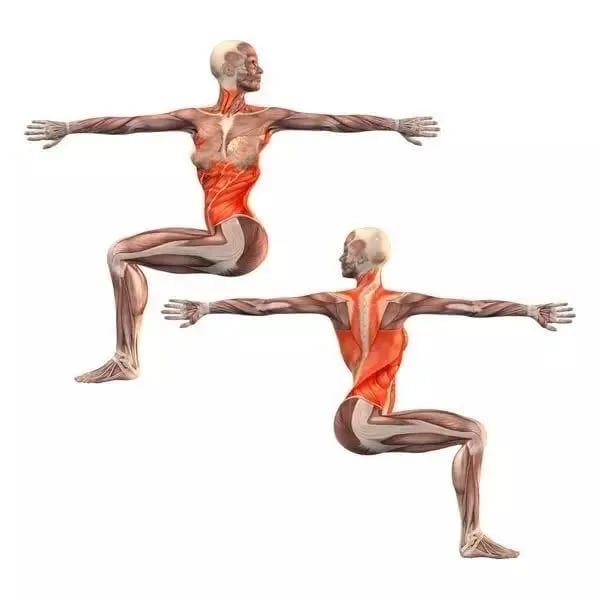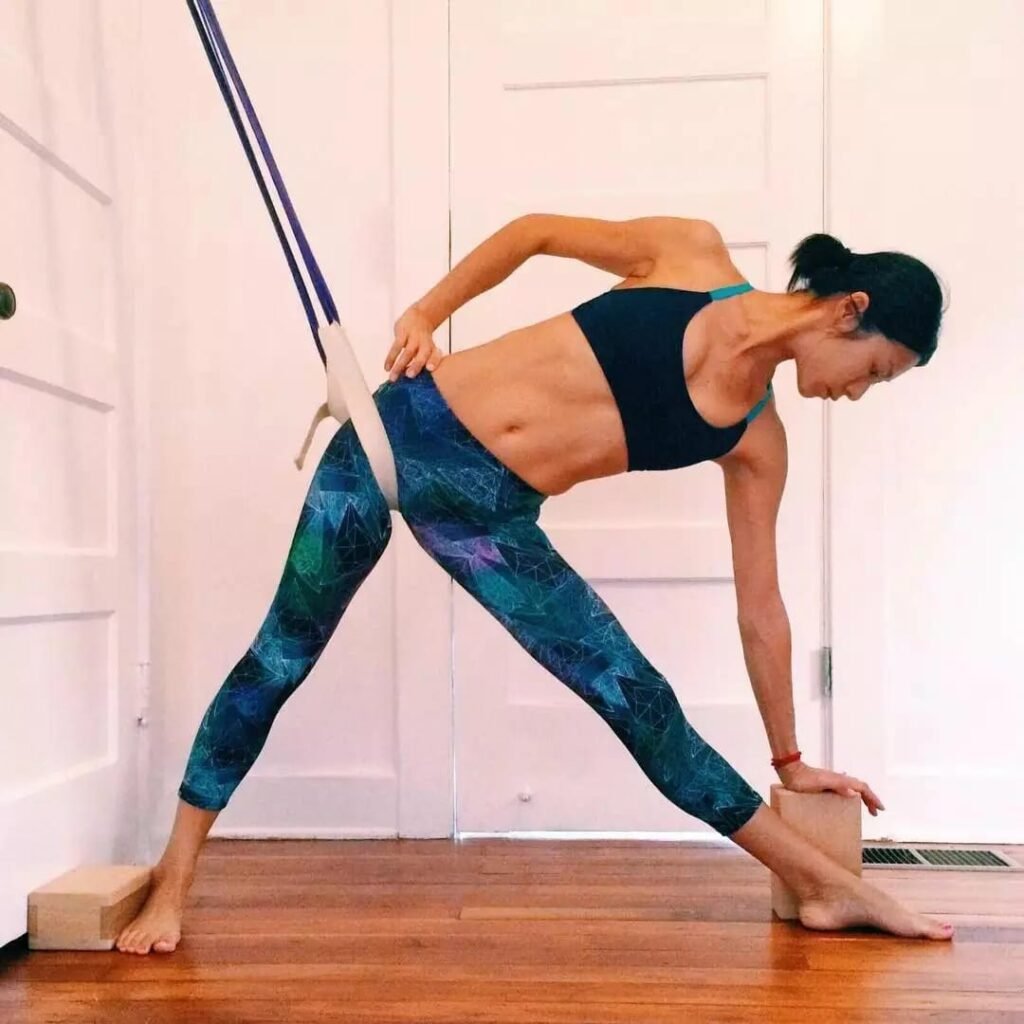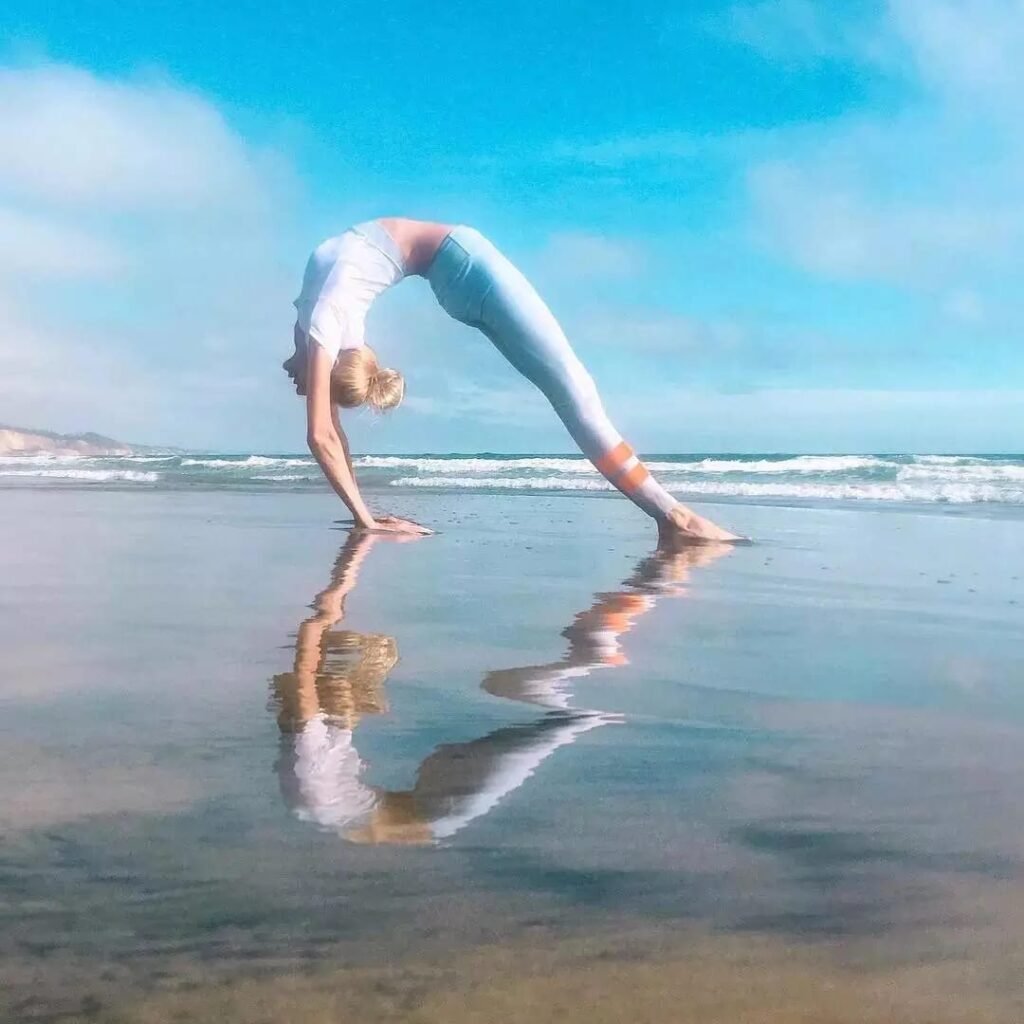Introduction
- Today, I will talk to you about “isometric stretching”.
- This sentence may sound unfamiliar, but you must have heard of “bilateral waist isometric stretching”, which is a very important detail of side bending poses.

What does a bilateral isometric stretch mean in side bends?
Let’s start with the classic side bend pose: Triangle.
This is a triangle pose that bends to the left, which can also be understood as folding the body from the position of the groin on the outside of the left leg. A particularly easy mistake to make here is shortening the left waist and lengthening the right waist. The lines of the waist on both sides should have been two parallel lines of equal length, but now they have become two parallel arcs. The large arc is surrounded by a small arc. Obviously, the upper arc is long and the lower arc is short. The reaction is in the posture, that is, the side waist that is shortened below is shortened and squeezed. What is an example of isometric stretching

- In side bending poses
- In a side bending type of pose
In side bending poses
It is not the extension of the upper waist that determines the range of entering the pose, but the extension of the lower waist determines the range of entering the side bend. The more the lower back is stretched, the greater the range into the pose.

In a side bend type of pose
Your focus is more on the lower side stretch. Let the lower side waist stretch as much as possible, keep the hips away from the armpits, and at the same time you have to cut inward from the outside of the groin, let the top of the head bring the spine, and let the lower side waist go obliquely upward in a straight line, without arc, not inward roll. This is a bilateral isometric stretch in a side bend-like pose. I don’t know if you have found a familiar sentence: cut the groin inward, and walk diagonally upward with the spine on the top of the head.

Note
- If you can do that, the side waist stretch above doesn’t matter at all.
- To sum up, the posture of bending to the left is actually the extension of the left waist, which determines the entire postage.
What is the key points of forward bend?
Inwardly cut the groin, lift the pubic bone to the navel, lift the navel to the ribcage, lengthen the front of the body, let the head and neck lead the spine to go obliquely upward, do not let the abdomen and rib cage sink inward go in. In fact, the front side of the body is elongated here, and the abdomen and ribcage should not be sunk inward. To put it bluntly, it is to extend the front and rear sides of the spine equally. Because in forward bends the front side tends to be shortened and the back side tends to be elongated.
- To sum up, the forward bending posture is actually the extension of the front side of the body, which determines the entire posture range.
What is the most common mistake to make in backbends?
Let’s look at the backbend again. What is the most common mistake to make in backbends? Folding from the position of the lumbar spine can actually be understood as the front side of the spine becomes longer and the back side becomes shorter, and the lumbar spine is squeezed.
- So the main points of the backbend: lift the rib cage, add the scapula, extend the spine, and extend the lumbar spine.
- Have you noticed that the focus of these details has come to the back of the body again, so much is done to ensure that the back of the body is fully extended and not shortened? That is to say, the extension of the back of the body cannot be sacrificed to achieve the extension of the front of the body.

To sum up, the posture of bending backward and the extension of the back of the body determine the range of the entire posture.
Look at the twist again. We just talked about twisting two days ago. When the body twists to the left, keep the extension of the left waist. It can also be said that the degree of extension of the left waist determines the degree of twist.
- When it comes to this, you should have discovered the pattern long ago: the parts you want to stretch don’t actually need to be too concerned. Forward bending is to stretch the back, keep the front side not shortened, and extend the front side as much as possible; bend to the left, stretch the right side, watch the left side bend without shortening, and extend the left side; backbend asana stretches the front side, see Hold the back side without shortening, and extend the back side; the asana twisting to the left stretches the right side, watching the left side without shortening, and extends the left side. Let the front, back, left, and right stretches reach a balance, and there will be no squeezing, arched back, or chest collapse, one hip is pushed out, and the side waist is squeezed.
Think about it this way, fully extending the spine, and stretching the front, back, left, and right lengths can avoid mistakes and squeeze. Read more updates and tips about health on http://www.facefof.com
